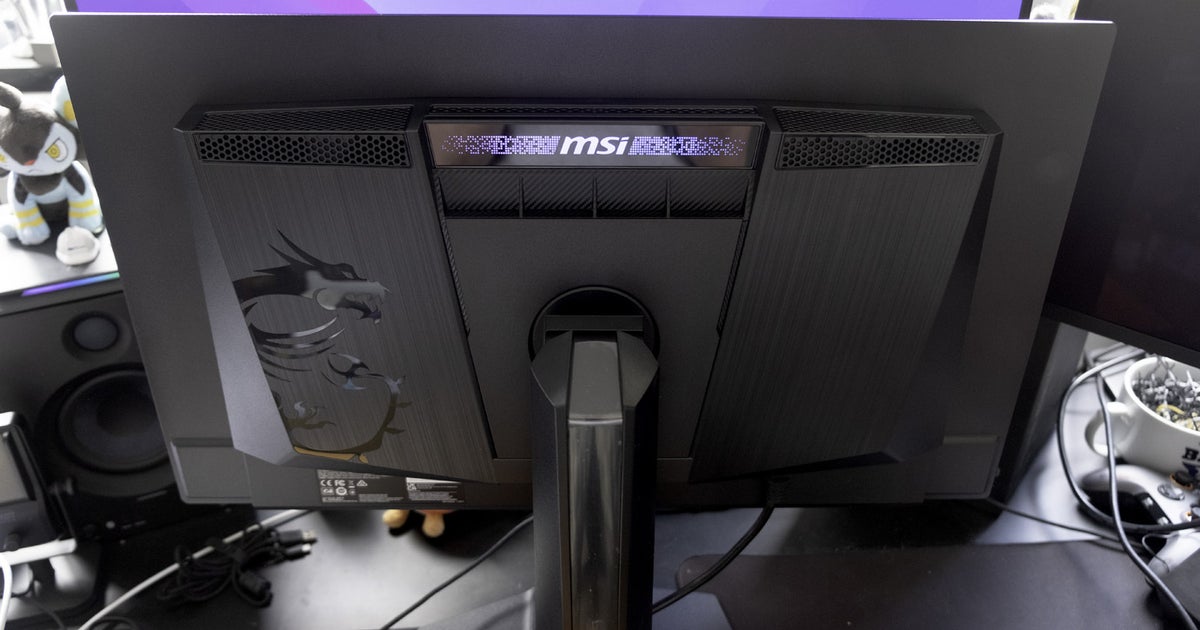Right now, the best gaming monitor you can get is probably a QD-OLED 4K 240Hz model from MSI, Dell or Asus. Some compelling options using third-gen Samsung QD-OLED panels arrived last year in a 32-inch form factor, and now we’re seeing the same specs in a more compact 27-inch design. That should allow for better compatibility with smaller desks, better glanceability for esports and crisper text rendering at 166PPI, but how does it work in practice?
To find out, we’re reviewing MSI’s brand new $1099/£989 MPG 272URX. As this is one of several models from different companies to be based around the same panel, we’re looking for MSI to differentiate itself on the basis of price, tuning, features and design.
If you’re not up to date on QD-OLED monitors, it’s also worth mentioning that these panels tend to do excellently for HDR content, thanks to their ability to turn off individual pixels for perfect blacks and unmatched contrast, with excellent colour reproduction, viewing angles and response times too. The downside to OLED is that these monitors are expensive and there’s the risk of permanent burn-in on static content, though this is extremely unlikely with varied usage and there are countermeasures installed to prevent this.
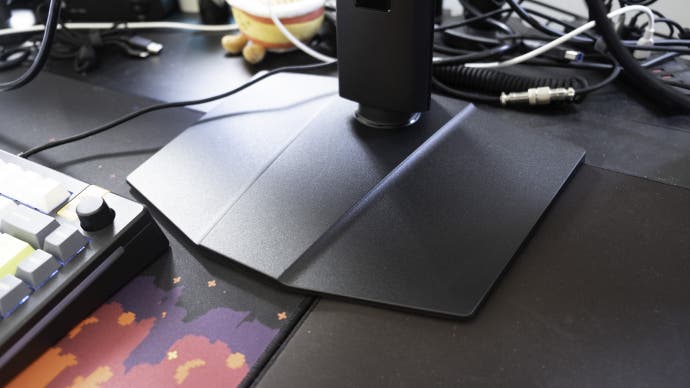
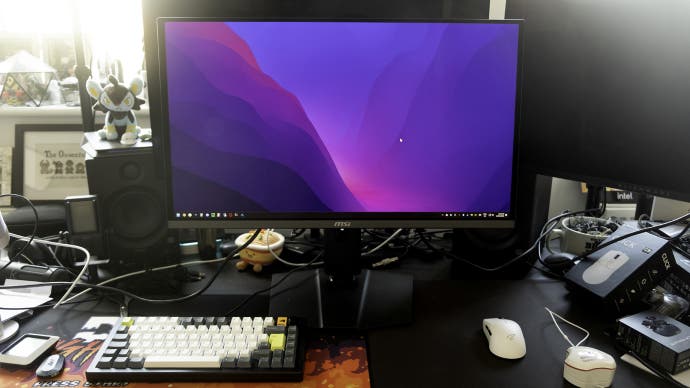
Like prior MSI QD-OLED monitors, the MPG 272URX benefits from a relatively understated design, with slim bezels on three sides of the monitor and a grey/silver bar on the underside with an MSI wordmark in the centre. The base here is quite compact, with a ridge in the centre and flatter edges that are easy enough to rest a keyboard on. The stand supports up to 110mm of height adjustment, as well as the usual tilt (25°), swivel (60°) and pivot, so you can position the monitor fairly easily. We’d normally recommend using a monitor arm with any high-end monitor for its ergonomic and desk real estate benefits, but the design here is sensible enough for this not to be a required day one purchase. The back of the monitor is replete with vents to keep the panel cool – be sure to take off the included plastic strips off to let them breathe! – and fairly restrained RGB MSI logo in the top centre.
MSI takes more of a step forward with its OSD, which is both well-designed (especially versus the spartan Dough Spectrum Black 32 we looked at recently) and extremely dense in terms of features. In terms of purely gaming features, there are crosshairs, multi-stage zoom with Optix Scope, AI Vision to adjust monitor parameters to highlight dark areas, a timer function and a host of preset modes for different game genres.
There’s also more general fare suitable for content creators, including sRGB, Adobe RGB and Delta P3 modes for targeting different colour gamuts, 98W USB-C charging for connecting a laptop with a single cable, PIP/PBP modes and a KVM switch. I really appreciate these latter inclusions, as being able to easily use your shiny new high-end monitor with a gaming laptop or MacBook Pro over a single cable makes the monitor feel like a much better value purchase.
MSI has always done well to give users extra options for OLED care in particular, and that’s true with the 272URX with options for pixel shifting, screensavers, static screen detection, logo detection, taskbar detection and boundary detection. It’s an extremely comprehensive list and it’s backed by a three-year warranty that covers burn-in, making MSI one of the premiere options in my estimation when it comes to OLED-based monitors.
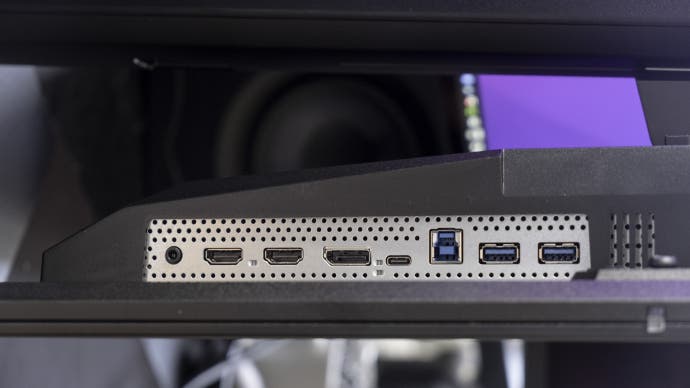
In terms of ports, we have a fairly standard assortment, including two HDMI 2.1 ports – supporting the full 3840×2160 resolution at 240Hz with HDR, a 3.5mm headphone output, a USB-C with alt-mode support and the aforementioned 98W charging, USB-B for the USB hub and two USB-A ports on the underside which can be used for upgrading the firmware.
You’ll note I didn’t mention the DisplayPort, which as a DP2.1 UHBR20 (80Gbps) port deserves special mention. This is an expensive port to include – which is why Dell opted for an older DP 1.4 port with their equivalent, the $900 AW2725Q – but it allows for full connection speeds without DSC (display stream compression). Personally, I’m fine either way, but for those that want to use their latest-gen Nvidia or AMD graphics cards at full bandwidth, the 272URX has you covered.
To see how the 272URX performs, we subjected it to the usual battery of DF monitor tests in DisplayCAL and SpyderX using a SpyderX Elite colourimeter. (We have an even more advanced SpyderX Pro on the way, but it didn’t arrive in time for this review.)
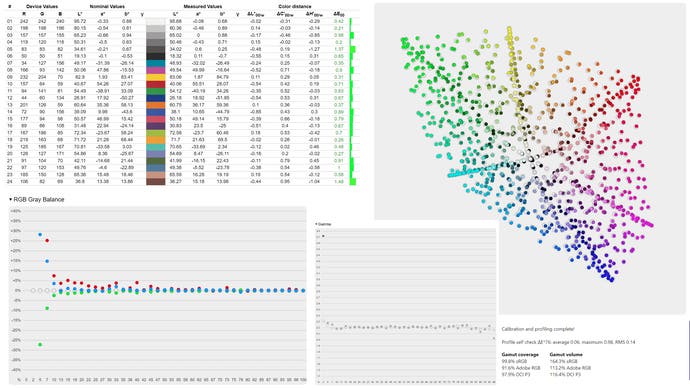
Perhaps unsurprisingly, the results here are extremely strong – the 272URX is one of the best calibrated monitors we’ve ever tested, with extremely good colour accuracy scores (0.3 average Delta-E 2000, or below the limits of human perception), excellent panel uniformity in terms of both brightness and colour and solid tracking of the Adobe RGB, Delta P3 and sRGB colour spaces in the monitor’s respective modes.
Add on the usual OLED advantages – near-instant pixel response times, wide viewing angles, infinite contrast – and you’ve got an excellent option for a wide range of gaming and content consumption or creation scenarios. The contrast and richness of colour is particularly apparent versus even high-end LCD displays, and there are also noticeable improvements to text clarity thanks to the fourth-gen QD-OLED panel used here. I particularly noticed how much sharper text looks compared to the 32-inch 4K QD-OLED I use as my daily driver, due to the higher PPI of the 272URX.
Brightness is perhaps the only slight weakness here, with around 250 nits in SDR or 1000 nits in a small (three percent) window in HDR. Note that there are two modes, one that targets 400 nits without ABL (auto brightness limiting) and one that targets 1000 nits with ABL. I find ABLs a bit distracting, so I opted for the 400 nit option for most of my testing and was generally very happy with the quality of the HDR reproduction. I also didn’t find the 250 nits of SDR brightness too dim for daytime use in moderate sunlight, versus earlier OLEDs that only reached around 200 nits… though combining extremely sunny days with dark scenes in games or movies may require you to draw the curtains to make out the details.
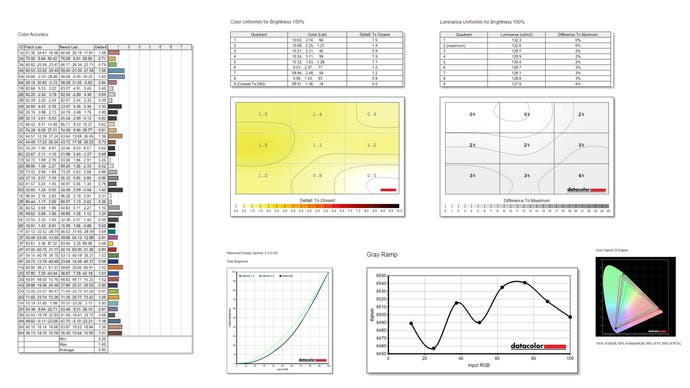
Burn-in is also technically possible here, though I’ve not seen any signs of this on my 32-inch QD-OLED after a full year of use in content creation and gaming with minimal precautions, such as dark mode in Windows and leaving various OLED care measures at their default values. Monitors Unboxed are doing a more extreme test with almost no precautions on a similar panel, and have found only minor changes after a similar time period. With this in mind, I’m still perfectly happy to recommend OLEDs for mixed usage or pure gaming scenarios, though if you’ll be working on your monitor for eight hours a day – especially if you’ll be spending most of that time in a single app – you’re better off with an LCD alternative.
For gaming in particular, the 272URX shines. The smaller span of the 27-inch QD-OLD is better suited for esports than 32-inch equivalents, where you want to sit close to the screen to make hitting distant opponents easier while still being able to see things like the radar and remaining ammo without moving your head. There’s even a 24-inch emulation mode if you want to lock in even further.
The legendarily quick OLED pixel response times and high refresh rate are also a blessing for fast-paced games of any genre, while contrast, colour reproduction and HDR support are top-notch and enhance games of all stripes (I don’t consider the lack of Dolby Vision support a significant factor given the extremely lacklustre PC experience). You can also use this screen for gaming on PS5 Pro, PS5 or Xbox Series X, though you’ll top out at 4K 120Hz on these systems.
Caption
Attribution
Overall then, the 272URX is a fantastic monitor that is easy to recommend for owners of extremely high-end gaming PCs – think those equipped with RTX 4090, 5080 or 5090 graphics cards – that want to fully max out the latest games. MSI has done well to differentiate their 27-inch QD-OLED offering from rivals Asus and Dell with some clever features, a pleasant design and suitability for a wide range of gaming and non-gaming tasks.
At $1099/£989, it doesn’t come cheap, but this is effectively the price of being on the very cutting edge. If you prefer a more compact monitor than the 32-inch alternatives that debuted last year, this is a good choice – especially for esports or similarly competitive gaming. However, it’s worth noting that those 32-inch QD-OLED models are probably closer to being discounted, and having a larger monitor based on the same core tech at a similar price is probably worthwhile if you have the space for it. Still, it’s nice to have the option, and given the popularity of 27-inch gaming monitors, I suspect these will do OK.
